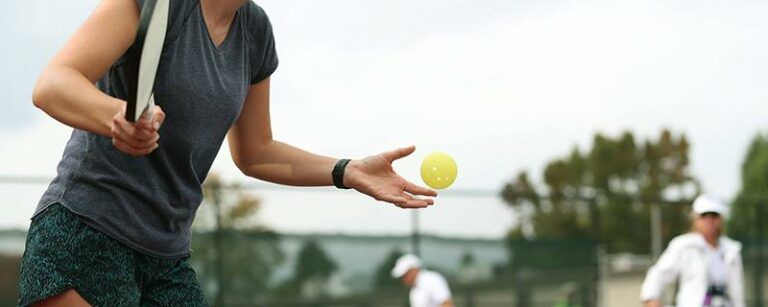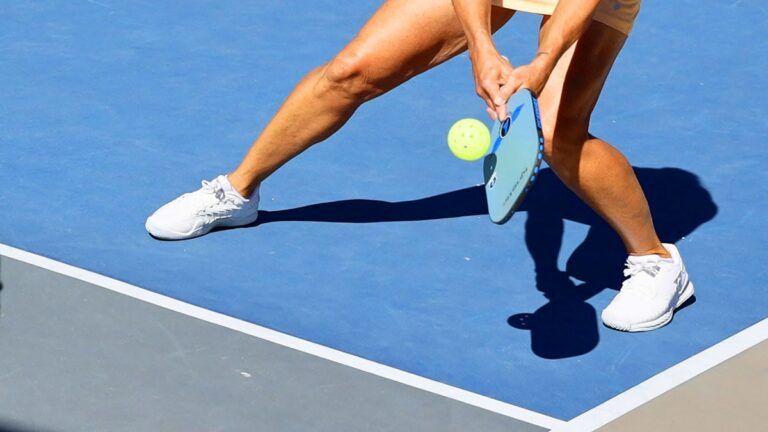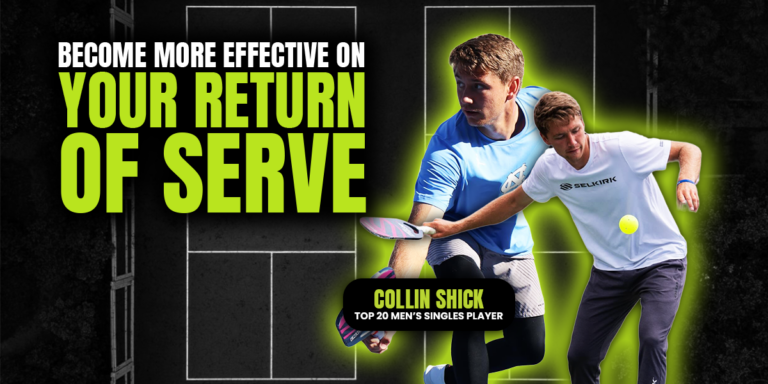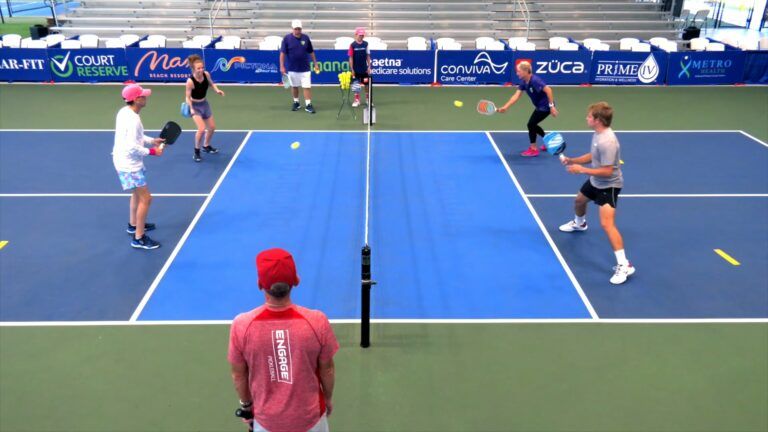Pickleball Tips for Intermediate Players - Mastering the fundamentals
The foundation of a great pickleball game lies in mastering fundamental skills. While intermediate players may already have a grasp on the basics, refining these skills can lead to significant improvements in performance. The grip and stance, in particular, serve as the bedrock for effective play.
Grip and stance: the foundation of your game
Understanding the pickleball grip is crucial for controlling your shots effectively. The continental grip is often recommended because it allows players to handle various types of shots, from forehands to serves. Imagine your paddle as a painter's brush, and how you hold it determines the strokes you can create on the canvas of the court. Practicing this grip will offer a balance between power and touch.
Your pickleball stance is equally important. A balanced, athletic stance with your knees slightly bent enables quick movements in any direction. Being grounded and ready can be likened to a coiled spring, ready to unleash energy when the moment arises. To sum it up, the right grip paired with a strong stance will provide the player with the agility and precision needed to execute complex shots.

Perfecting your serve: placement and power
A well-placed serve can be a weapon in your arsenal. It's the first shot of each rally, setting the tone and strategy for what follows. A powerful serve can intimidate opponents, but its placement can be just as impactful. Variability in your serves keeps opponents guessing. Do you convey the strength of your serve like a lion’s roar, or the finesse of a whispering breeze?
Focusing on different types of pickleball serves such as underhand, topspin, or side-spin lets you adapt to your opponent's weaknesses. Visualize your serve like a dart hitting a bullseye: precision is key. Additionally, consider incorporating a serving strategy that targets the corners of the service box, margins that can be difficult for your opponent to return efficiently.

Building consistency with basic shots
As an intermediate player, building consistency in your basic shots can profoundly enhance your gameplay. The forehand and backhand shots should become second nature. Just as a musician practices their scales, mastering these strokes will allow you to express greater creativity during play.
Practice drills can help solidify these shots, focusing on repetitive actions until they become almost instinctive. The goal is not simply to hit the ball but to hit it well. Encourage yourself to hit the ball where you want it to go, instead of simply returning it. Combining basic consistency with placement awareness can significantly increase your chances of winning rallies.

Strategic shot placement
Having the ability to place your shots accurately is crucial in outwitting your opponents. An essential part of intermediate play is understanding the dynamics of shot placement and how to leverage opponents' weaknesses.
Aiming for the feet: creating defensive challenges
One of the simplest yet most effective strategies is to aim for your opponent’s feet. When a ball is directed toward their feet, it forces them to return low, making it difficult to generate power. This is akin to throwing a pebble into a pond; the ripples create disturbances that unsettle the calm surface. By targeting the feet, you can create defensive challenges and open up opportunities for offensive plays.
In practice, targeting pickleball shot placement should become intuitive. It’s about reading your opponent’s stance, understanding their preferred shot, and executing your plan with precision. The reward lies in forcing them to react rather than dictating the game.

Hitting to the weaker player in doubles
In doubles play, it’s essential to identify and exploit weaknesses. If one opponent has a noticeably weaker backhand, use your shots to direct the play toward them. This tactic can unsettle the team’s balance, rather like a basketball player targeting the weaker defender in a pick-and-roll scenario. Engaging in discussions with your partner about potential targets can create a strategic overlay to your gameplay, enhancing team dynamics.
Effective doubles strategy relies not just on individual skills but also on teamwork. Communicate regularly about your observations to help create attacking opportunities and maintain pressure on your opponents. Understanding the importance of targeting opponents’ weaknesses can transform your doubles play into a series of tactical maneuvers.
Returning serves with purpose
The return of serve can be a pivotal moment, shaping the next phase of the rally. A poor return can send you on the defensive, while a solid return can equalize the court dynamics in your favor. When returning serves, aim to capitalize on the server's weaknesses. Your goal should be to hit deep shots that will push them into a corner, a tactic that not only destabilizes their position but may also open up the court for an attack.
Incorporating this pickleball serve return strategy will create a rhythm for your game, almost like a dance. Know when to be aggressive and when to play it safe; this will make your returns a challenge for even the most seasoned opponents.

The art of the dink
Dinking is a delicate art that can significantly shape the pace of a game. Intermediate players must embrace this soft shot, which often draws errors from the opposition and sets the tone for a more strategic rally.
Understanding the dink: the cornerstone of soft play
Imagine the dink shot as a gentle whisper in an energetic conversation; it lowers the tempo and disrupts the established rhythm, causing opponents to reconsider their approach. By learning the pickleball dink, you take plays into an area where precision becomes key.
Practicing dinks can elevate your game's quieter moments. Focus on the soft touch and the correct angling of your paddle to keep the ball in the non-volley zone. Strive for low dinks just over the net to force your opponents to adjust their positioning and strategy, resulting in possible errors or poor returns.

Footwork for dinking: quickness and agility
Effective footwork is essential for executing successful dinks. A well-timed foot adjustment can turn an average shot into a strategic play. Maintain a position that allows you to pivot swiftly between offensive and defensive plays. Great footwork is akin to a cat’s steady leap dynamic yet graceful.
A series of pickleball dinking footwork drills can help hone these skills, enhancing your agility and response time, qualities invaluable in high-pressure game scenarios. Thus, refining your footwork not only aids in dinking but boosts overall game efficiency.
Court positioning for dinking: the non-volley zone
The non-volley zone, often referred to as the kitchen, serves as a critical battlefield in any pickleball match. Positioning yourself effectively in this zone heightens your ability to control the game flow.
Stay ready at the kitchen line, maintaining a low center of gravity that facilitates quick movements. When opponents engage in dinks, your position should allow for immediate responses or counter-dinks, increasing your chances of dictating play.
Developing an aggressive game
Transitioning from intermediate to advanced play requires an aggressive mindset. Knowing when to attack versus when to play conservatively can mean the difference between winning and losing crucial points.
Knowing when to attack: recognizing opportunities
Identifying opportunities to transition from defense to offense involves keen observation and analysis of the game. Think of it as a predator observing its prey; patience pays off. High-pressure moments, such as when your opponent is slightly off-balance or hits a weak return, are prime times to execute your own aggressive strategy.
Aggressive play is not merely about throwing caution to the wind; it’s systematic and deliberate. An informed decision to attack can lay the groundwork for creating scoring opportunities that definitively shift gameplay momentum in your favor.
Deep serves and returns: controlling the court
Executing deep serves and returns can control the pace of the game right from the onset. When serving deep, ensure your shot reaches the back of the service box, pushing opponents back and creating room for your follow-up play. Similarly, deep returns can force opponents to rethink their entire play, encouraging errors.
The intent behind these shots should reflect control like a conductor leading an orchestra. A well-placed deep ball sends a clear message about your intentions and keeps opponents on their toes.
Forcing backhands: targeting the weaker side
Targeting an opponent's backhand during play can yield fruitful results. Most players have a preferred side, and if you exploit their backhand, you can create numerous opportunities, pushing them into uncomfortable returns.
A well-timed strike to the opponent’s backhand can scatter their focus. Think of this tactic as a chess player outmaneuvering their opponent; with foresight and intention, you can gain the upper hand in rallies.
Dominating doubles play
Doubles play in pickleball isn’t just about two players working together; it’s about creating a cohesive strategy that enhances each partner's strengths and minimizes weaknesses. Mastering the art of teamwork can profoundly impact your success on the court.
Communication: the key to successful teamwork
In doubles, clear communication is non-negotiable. It’s vital to signal intentions and responsibilities with phrases like “yours” or “mine.” Effective dialogue maintains team cohesion and minimizes blunders, allowing each player to focus on contributing to collective performance.
Utilizing strong communication could be likened to a well-oiled machine; each gear works optimally when every part is in sync. Dedicating time to practice communication can strengthen team strategies and enhance overall gameplay.
Strategic player positioning
Understanding pickleball doubles strategy is critical; each player should occupy positions that capitalize on individual strength. Explore various formations (such as stacking) to find what works best for your team’s dynamics. Forcing opponents into difficult shots allows you to maintain the offensive edge consistently.
Positioning is not static; it shifts based on the play. Studies suggest that adaptable teams with fluid positioning fare better in matches as they can quickly respond to opponents’ plays.
Reading your partner's movements
Anticipating your partner's movements enhances synergy on the court. Just as dancers must be in sync with their partners, pickleball players should quietly but efficiently read each other's intentions. This allows for smoother transitions between shots and reduces the likelihood of missed opportunities.
Observing nonverbal cues from your partner can create an almost telepathic connection during gameplay. Your awareness of their positioning will dictate your readiness to support or switch strategies based on the flow of the game.
Mastering the drop shot
Learning to effectively execute a drop shot can become a game-changer. This delicate play requires finesse and an intrinsic understanding of court dynamics.
The deceptive drop shot: technique and finesse
The drop shot is less about power and more about subtlety. It should be executed with just the right touch to confuse opponents. Setting up for a drop shot is akin to a magician performing a trick, where the skill lies in making the ball appear in an unexpected place.
Practice maintaining a low trajectory with your drop shots, ensuring they clear the net barely and land inside the non-volley zone. This tactic can induce errors from opponents, creating opportunities for you to take control.
Strategic drop shot placement
Placement is key when performing a drop shot. Aim for corners or areas that can catch opponents off guard. Visualize the court like a chessboard, where each move requires reflection and strategic planning.
Intentionally targeted drop shots will draw opponents forward, allowing you to exploit their positioning with a sudden change in play maybe transitioning to a more aggressive shot the moment they commit.
Avoiding common drop shot mistakes
Many players struggle with common errors associated with drop shots namely, incorrect height or inconsistent bouncing. The goal is to practice until you develop an intuitive sense for the drop shot’s execution.
Develop a routine that focuses not only on technique but also on mental preparation. Mental practice can bolster your confidence when executing drop shots during high-pressure scenarios in an actual match.
Volleying like a pro
High-energy rallies often depend on how well players execute volleys. Mastering this skill can take your gameplay to new heights.
Proper volleying technique
When executing volleys, maintain optimal paddle positioning, ensuring it is ready to intercept incoming shots. Positioning your paddle to meet high-energy shots requires both agility and technique. Think of volleying as a dance of expressions, where every movement reflects intention and skill.
Practicing volleying drills, such as tapping the ball against a wall, can build confidence. Adding variety like practicing both forehand and backhand volleys ensures you’re well-rounded in every aspect of the game.
Non-volley zone positioning
Maintaining a solid position in the non-volley zone is crucial for effectively volleying incoming shots. Ideally, players should remain low and balanced, preparing to navigate ground-level plays.
Refining pickleball kitchen positioning can create a formidable barrier against opponents and enhance your responsiveness during fast-paced rallies. It’s crucial to ensure that you are prepared to volley or transition quickly based on the court’s dynamics.
When to volley, when to dink: reading the play
Understanding when to switch from a volleying approach to dinking is essential for intermediate players. The fluidity of decision-making can dramatically impact gameplay quality. It’s a dance of predilection; you must learn to read your opponent's movements and adjust your tactics accordingly.
When in doubt, observe body language if an opponent is positioned defensively, leaning back, it may be your cue to volley aggressively. Continuously assessing the flow and rhythm keeps the game interesting.
Conquering common mistakes
Finally, addressing common mistakes will ensure that you continue to grow in skill and confidence on the court.
Correcting drop shot errors
Drop shots can often be misplayed due to incorrect execution or the player’s nervousness in critical moments. With practice, players can learn to maintain control and awareness of their drop shots’ height and direction.
Focusing on pickleball drop shot control drills can build consistency and confidence in this vital shot. Consider integrating specific training sessions that target this shot alone, allowing you to focus and refine your technique.
Maintaining low dink trajectories
One common error with dinking is hitting too high, resulting in simple returns for opponents. A good rule of thumb is to visualize your dinks as low, controlled shots aimed to elude opponents while still remaining in the non-volley zone.
Possible pickleball dinking technique drills can assist players in honing their skills, ensuring consistent performance under various game conditions. Developing a keen sense of height will make your dinking plays more effective.
Adding spin to your shots
Incorporating spin into your shots adds unpredictability to your gameplay. As a player, mastering both backspin and topspin can create dynamic shots that are difficult for opponents to return effectively.
The mental game: winning strategies
An often overlooked factor in pickleball is the mental game. Preparing your mind for matches can be the differentiator between good and great players.
Mental preparation: warm-up routine and focus
Prior to matches, developing a warm-up routine that fills you with the right mindset is crucial. Think of it as laying the groundwork for success a ritual that prepares the body and mind for the competition ahead. By nurturing your mental readiness, your gameplay can flourish.
Analyzing your opponent: finding weaknesses
A strategic mindset within gameplay involves observing and analyzing your opponents’ patterns. As you become more adept at pickleball strategy, take note of their weaknesses and adjust your tactics accordingly.
Staying positive: the power of a positive mindset
Finally, maintaining a positive attitude throughout the game can dramatically influence performance. Emphasizing sportsmanship and the enjoyment of play can elevate not just your experience, but those of your teammates and opponents as well.
Developing these strategies will inch you closer to becoming a formidable force on the pickeball court, effectively blending physical skills with mental acuity.
In conclusion, intermediate players can take their game to the next level by consistently honing a blend of technical skills, teamwork strategies, and mental fortitude. These essential tips are not merely checklists; they are building blocks that fuse together, helping you evolve into a more skilled and strategic pickleball player. As the game continues to grow, each player contributes uniquely to its vibrant competitive tapestry, each point a thread woven into a larger story. Embrace the journey, practice, and enjoy every moment spent on the court.










